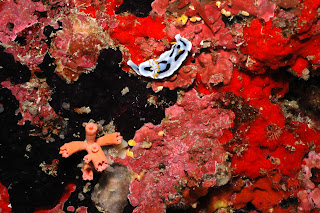Most red algae are multicellular plants that grow on rocks or other algae. Some of the most common red algae are encrusting forms that spread over hard surfaces, forming pink or red films on rocks and animal shells. Some other species of red algae develop tall plants with leafy fronds.
The encrusting coralline red alga Porolithon is especially noticeable on reef crests where it makes up much of the plant population. Porolithon is a tough plant that can endure occasional drying as well as intense wave action. Like the green alga Halimeda, Porolithon deposits calcium carbonate in its cell walls, giving it a rocklike texture. In all parts of the reef, this alga forms calcium carbonate that eventually finds its way into the reef. Calcium carbonate in Porolithon also acts as a mortar, cementing loose pieces of sand and rubble onto the reef structure. As a result, it improves the reef’s overall strength and replaces much of the material that is lost to erosion.
Upright varieties of red coralline algae develop calcified branches that are jointed by uncalcified sections of frond. Tall red coralline algae are somewhat flexible and sway with the motion of tides and currents. Their hard cell walls protect them from damage by moving water and from grazing by predators.
Most species of red algae grow relatively slowly and have complex life histories that include phases of both sexual and asexual reproduction. Nori (Porphyra) are reef seaweeds that look like limp, purple sheets. Nori uses a reproductive strategy called alternation of generations that is fairly typical of red algae. Both sexual and asexual reproductive structures are located on the thallus, or body, of nori. The asexual segments form spores that germinate to form new thalli. In the sexually reproducing sectors of the thallus, male and female cells release gametes that combine to form zygotes. These zygotes undergo cell division that results in spores. The spores settle onto the shells of animals such as crabs and barnacles where they grow into filamentous structures that bore into their hosts’ shells. When the shell-boring phase of Porphyra matures, it then produces spores. Within these spores, cells undergo a special type of cell division called meiosis that reduces the amount of genetic material in each cell by half. These daughter cells settle to the bottom and grow into new thalli, bringing the process back to full circle.
In many types of algae, sperm are released into the sea, but female cells remain in the thallus. To ensure that the freeswimming sperm will find the eggs, some species use pheromones, chemicals that serve as signals. When eggs discharge their pheromones, sperm can follow them, like trail markers, to the eggs. Without pheromones, the sperm and eggs of some species would be unable to unite.

